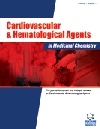-
oa Role of Cellular Elements in Thrombus Formation and Dissolution
- Source: Cardiovascular & Hematological Agents in Medicinal Chemistry, Volume 6, Issue 3, Jul 2008, p. 224 - 228
-
- 01 Jul 2008
Abstract
Although fibrin forms the core matrix of thrombi, their structure depends also on the cellular elements embedded in its meshwork. Platelets are essential in the initial stages of thrombus formation, because they adhere and aggregate at sites of blood vessel wall injury and then serve as a surface for coagulation reactions, the overall rate of which determines the final structure of fibrin. In addition, platelets affect fibrinolysis through their proteins and phospholipids, which modulate plasmin activity. Leukocytes form mixed aggregates with platelets and thus influence the structure of thrombi. After activation they secrete different proteases (elastase, cathepsin G, matrix metalloproteinases) that enhance the von Willebrand factor-dependent platelet adhesion. Leukocyte-derived enzymes, first of all elastase, effect fibrinolysis by direct digestion of fibrin or indirectly modulate it by partial degradation of zymogens and inhibitors of coagulation and fibrinolytic proteases.


